Model Analysis of Eco-Innovation for National Decarbonisation Transition in Integrated European Energy System
Abstract
:1. Introduction
2. Literature Review
2.1. Research Review on the Environmental Component of Innovative Regional Systems
2.2. Ecological Regulation of Energy Consumption
3. Methodology
3.1. Sectoral Study of Greening the Economy in the Energy Industry
3.2. Screening Method
3.3. Mathematical Modelling
4. Results
4.1. Decarbonisation and the “Green Transition” as an Innovative Component of Sustainable Economic Development of Ukraine
- -
- Continuous and sustainable growth of the socio-economic level of the region, based on innovative entrepreneurial activity, smart specialisation of the region, a significant level of competitiveness, adaptation to market changes, and flexible response to infrastructure challenges and political conditions;
- -
- Constant self-development based on the constant growth of social needs of the region, which must be ensured by constant commercialisation of innovations, and as a consequence, the formation of new social needs of higher quality and the cyclical nature of further innovative development;
- -
- Causal relationships, which are reflected in the interaction and motivation of regional development stakeholders.
4.2. Influence of State Regulation on the Process of Decarbonisation/Adaptation in the Region
4.3. Applied Models of Decarbonisation of Energy-Intensive Sectors
5. Conclusions
Author Contributions
Funding
Institutional Review Board Statement
Informed Consent Statement
Data Availability Statement
Conflicts of Interest
References
- European Commission. A European Green Deal. 2019. Available online: https://ec.europa.eu/info/strategy/priorities-2019-2024/european-green-deal_en (accessed on 29 March 2022).
- Klaniecki, K.; Duse, I.A.; Lutz, L.M.; Leventon, J.; Abson, D.J. Applying the energy cultures framework to understand energy systems in the context of rural sustainability transformation. Energy Policy 2020, 137, 111092. [Google Scholar] [CrossRef]
- State Statistics Service of Ukraine. Available online: http://www.ukrstat.gov.ua (accessed on 10 April 2022).
- Ministry of Environmental Protection and Natural Resources. The concept of “green” energy transition of Ukraine until 2050. 2020. Available online: https://mepr.gov.ua/news/34424.html (accessed on 29 March 2022).
- Van den Berg, N.J.; van Soest, H.L.; Hof, A.F.; den Elzen, M.G.J.; van Vuuren, D.P.; Chen, W.; Drouet, L.; Emmerling, J.; Fujimori, S.; Höhne, N.; et al. Implications of various effort-sharing approaches for national carbon budgets and emission pathways. Clim. Chang. 2020, 162, 1805–1822. [Google Scholar] [CrossRef] [Green Version]
- Cader, J.; Olczak, P.; Koneczna, R. Regional dependencies of interest in the “My Electricity” photovoltaic subsidy program in Poland. Energy Policy J. 2021, 24, 97–116. [Google Scholar] [CrossRef]
- Long, X.; Chen, Y.; Du, J.; Oh, K.; Han, I. Environmental Innovation and Its Impact on Economic and Environmental Performance: Evidence from Korean-Owned Firms in China. Energy Policy 2017, 107, 131–137. [Google Scholar] [CrossRef]
- Sribna, Y.; Koval, V.; Olczak, P.; Bizonych, D.; Matuszewska, D.; Shtyrov, O. Forecasting solar generation in energy systems to accelerate the implementation of sustainable economic development. Energy Policy J. 2021, 24, 5–28. [Google Scholar] [CrossRef]
- Tang, M.; Walsh, G.; Lerner, D.; Fitza, M.A.; Li, Q. Green Innovation, Managerial Concern and Firm Performance: An Empirical Study. Bus. Strategy Environ. 2017, 27, 39–51. [Google Scholar] [CrossRef]
- Brunel, C. Green Innovation and Green Imports: Links Between Environmental Policies, Innovation, and Production. J. Environ. Manag. 2019, 248, 109–290. [Google Scholar] [CrossRef]
- Abbas, J.; Sağsan, M. Impact of Knowledge Management Practices on Green Innovation and Corporate Sustainable Development: A Structural Analysis. J. Clean. Prod. 2019, 229, 611–620. [Google Scholar] [CrossRef]
- Zhang, F.; Zhu, L. Enhancing corporate sustainable development: Stakeholder pressures, organizational learning, and green innovation. Bus. Strategy Environ. 2019, 28, 1012–1026. [Google Scholar] [CrossRef]
- Hetman, O.; Iermakova, O.; Laiko, O.; Nikishyna, O. Eco-innovations under conditions of glocalization of economic and sustainable development of the regional economy. Ekon. I Sr. 2019, 4, 69–82. [Google Scholar]
- Savina, N.; Sribna, Y.; Pitel, N.; Parkhomenko, L.; Osipova, A.; Koval, V. Energy Management Decarbonization Policy and Its Implications for National Economies. IOP Conf. Ser. Earth Environ. Sci. 2021, 915, 012007. [Google Scholar] [CrossRef]
- Anderlini, L.; Felli, L.; Immordino, G.; Riboni, A. Legal institutions, innovation, and growth. Int. Econ. Rev. 2013, 54, 937–956. [Google Scholar] [CrossRef] [Green Version]
- Iermakova, O.A. Economic effeciency of clusters functioning: Estimation and analysis of their impact on region’s competitiveness. Actual Probl. Econ. 2012, 137, 174–180. [Google Scholar]
- Capra, F.; Mattei, U. The Ecology of Law: Toward a Legal System in Tune with Nature and Community; Berrett-Koehler Publishers: Oakland, CA, USA, 2015. [Google Scholar]
- Komorowska, A. Can Decarbonisation and Capacity Market Go Together? The Case Study of Poland. Energies 2021, 14, 5151. [Google Scholar] [CrossRef]
- Komorowska, A.; Benalcazar, P.; Kaszyński, P.; Kamiński, J. Economic consequences of a capacity market implementation: The case of Poland. Energy Policy 2020, 144, 111683. [Google Scholar] [CrossRef]
- Matuszewska, D.; Kuta, M.; Olczak, P. Techno-Economic Assessment of Mobilized Thermal Energy Storage System Using Geothermal Source in Polish Conditions. Energies 2020, 13, 3404. [Google Scholar] [CrossRef]
- Benalcazar, P.; Komorowska, A. Prospects of green hydrogen in Poland: A techno-economic analysis using a Monte Carlo approach. Int. J. Hydrogen Energy 2021, 47, 5779–5796. [Google Scholar] [CrossRef]
- Wróblewski, P.; Niekurzak, M. Assessment of the Possibility of Using Various Types of Renewable Energy Sources Installations in Single-Family Buildings as Part of Saving Final Energy Consumption in Polish Conditions. Energies 2022, 15, 1329. [Google Scholar] [CrossRef]
- Dyczko, A.; Kamiński, P.; Stecuła, K.; Prostański, D.; Kopacz, M.; Kowol, D. Thermal and mechanical energy storage as a chance for energy transformation in Poland. Energy Policy J. 2021, 24, 43–60. [Google Scholar] [CrossRef]
- Kulpa, J.; Kamiński, P.; Stecuła, K.; Prostański, D.; Matusiak, P.; Kowol, D.; Kopacz, M.; Olczak, P. Technical and Economic Aspects of Electric Energy Storage in a Mine Shaft—Budryk Case Study. Energies 2021, 14, 7337. [Google Scholar] [CrossRef]
- Rutitis, D.; Smoca, A.; Uvarova, I.; Brizga, J.; Atstaja, D.; Mavlutova, I. Sustainable Value Chain of Industrial Biocomposite Consumption: Influence of COVID-19 and Consumer Behavior. Energies 2022, 15, 466. [Google Scholar] [CrossRef]
- Trushkina, N.; Pahlevanzade, A.; Pahlevanzade, A.; Maslennikov, Y. Conceptual Provisions of the Transformation of the National Energy System of Ukraine in the Context of the European Green Deal. Energy Policy J. 2021, 24, 121–138. [Google Scholar] [CrossRef]
- Van de Graaf, T. Fragmentation in global energy governance: Explaining the creation of IRENA. Glob. Environ. Politics 2013, 13, 14–33. [Google Scholar] [CrossRef]
- Toohey, M.; Krüger, K.; Sigl, M.; Stordal, F.; Svensen, H. Climatic and societal impacts of a volcanic double event at the dawn of the Middle Ages. Clim. Chang. 2016, 136, 401–412. [Google Scholar] [CrossRef] [Green Version]
- Koval, V.; Olczak, P.; Vdovenko, N.; Boiko, O.; Matuszewska, D.; Mikhno, I. Ecosystem of Environmentally Sustainable Municipal Infrastructure in Ukraine. Sustainability 2021, 13, 10223. [Google Scholar] [CrossRef]
- Nitsenko, V.; Mardani, A.; Streimikis, J.; Shkrabak, I.; Klopov, I.; Novomlynets, O.; Podolska, O. Criteria for Evaluation of Efficiency of Energy Transformation Based on Renewable Energy Sources. Montenegrin J. Econ. 2018, 14, 237–247. [Google Scholar] [CrossRef]
- United Nation Climate Change. The Paris Agreement—Publication. Available online: https://unfccc.int/documents/184656 (accessed on 29 March 2022).
- The Verkhovna Rada of Ukraine. State Target Program for Fair Transformation of Coal Regions of Ukraine until 2030. Available online: https://zakon.rada.gov.ua/laws/show/1024-2021-%D0%BF#Text (accessed on 29 March 2022).
- State Statistics Service of Ukraine. Available online: http://ukrstat.gov.ua/druk/publicat/Arhiv_u/Arch_reg.htm (accessed on 29 March 2022).
- Interfaks—Ukraina. Available online: https://ua.interfax.com.ua/news/general/804185.html (accessed on 29 March 2022).
- Polish Press Agency. A reconstruction plan for Ukraine is needed—EUR 100 billion from the EU. Available online: https://www.pap.pl/aktualnosci/news,1099121,premier-zaapelowalem-zeby-ue-nalozyla-embargo-na-rosyjski-wegiel-potrzebny (accessed on 29 March 2022).
- The Washington Post. Biden administration requests $32.5 billion in Ukraine aid and coronavirus funds. Available online: https://www.washingtonpost.com/world/2022/03/03/russia-ukraine-war-putin-news/#link-HRAPLUUIN5BHNIOMUNDOXZQEL4 (accessed on 29 March 2022).
- Environmental Performance Index. 2020 EPI Index. 2020. Available online: https://epi.yale.edu/epi-results/2020/component/epi (accessed on 29 March 2022).
- Dutta, S.; Lanvin, B.; Leon, L.R.; Wunsch-Vincent, S. Global Innovation Index 2021. Available online: https://www.wipo.int/edocs/pubdocs/en/wipo_pub_gii_2021.pdf (accessed on 29 March 2022).
- European Commission. Bloomberg Innovation Index—2021. Available online: https://ec.europa.eu/newsroom/rtd/items/713430/en (accessed on 29 March 2022).
- Snisarenko, O. Estimation of Innovative Potential in Regions of Ukraine. Ph.D. Thesis, Kharkiv National Academy of Municipal Economy, Kharkiv, Ukraine, 2008; pp. 20–44. [Google Scholar]
- Serbanica, C.; Constantin, D.L. Sustainable cities in central and eastern European countries. Moving towards smart specialization. Habitat Int. 2017, 68, 55–63. [Google Scholar] [CrossRef]
- Boehringer, C.; Rutherford, T. Integrated assessment of energy policies: Decomposing top-down and bottom-up. J. Econ. Dyn. Control 2009, 33, 1648–1661. [Google Scholar] [CrossRef]
- Sotnyk, I.; Kurbatova, T.; Kubatko, O.; Prokopenko, O.; Prause, G.; Kovalenko, Y.; Trypolska, G.; Pysmenna, U. Energy Security Assessment of Emerging Economies under Global and Local Challenges. Energies 2021, 14, 5860. [Google Scholar] [CrossRef]
- Ministry of Education and Science of Ukraine. Available online: https://mon.gov.ua/storage/app/media/innovatsii-transfer-tehnologiy/2020/08/za-2019-1-1.pdf (accessed on 29 March 2022).
- UNIAN. Available online: https://www.unian.ua/economics/finance/uryad-stvoryuye-chotiri-fondi-vidnovlennya-ukrajini-shmigal-novini-ukrajina-11727847.html (accessed on 29 March 2022).
- Diachuk, O.; Podolets, R.; Balyk, O.; Yukhymets, R.; Pekkoiev, V.; Bosack Simonsen, M. Long-term Energy Modelling and Forecasting in Ukraine: Scenarios for the Action Plan of Energy Strategy of Ukraine until 2035. 2019. Available online: https://orbit.dtu.dk/en/publications/long-term-energy-modelling-and-forecasting-in-ukraine-scenarios-f (accessed on 29 March 2022).
- Yang, L. Idiosyncratic information spillover and connectedness network between the electricity and carbon markets in Europe. J. Commod. Mark. 2022, 25, 100185. [Google Scholar] [CrossRef]
- Cucchiella, F.; D’Adamo, I.; Gastaldi, M.; Stornelli, V. Solar Photovoltaic Panels Combined with Energy Storage in a Residential Building: An Economic Analysis. Sustainability 2018, 10, 3117. [Google Scholar] [CrossRef] [Green Version]
- Wang, J.B.; Huang, L. A Game-Theoretic Analytical Approach for Fostering Energy-Saving Innovation in the Electric Vehicle Supply Chain. SAGE Open 2021, 11, 21582440211021581. [Google Scholar] [CrossRef]
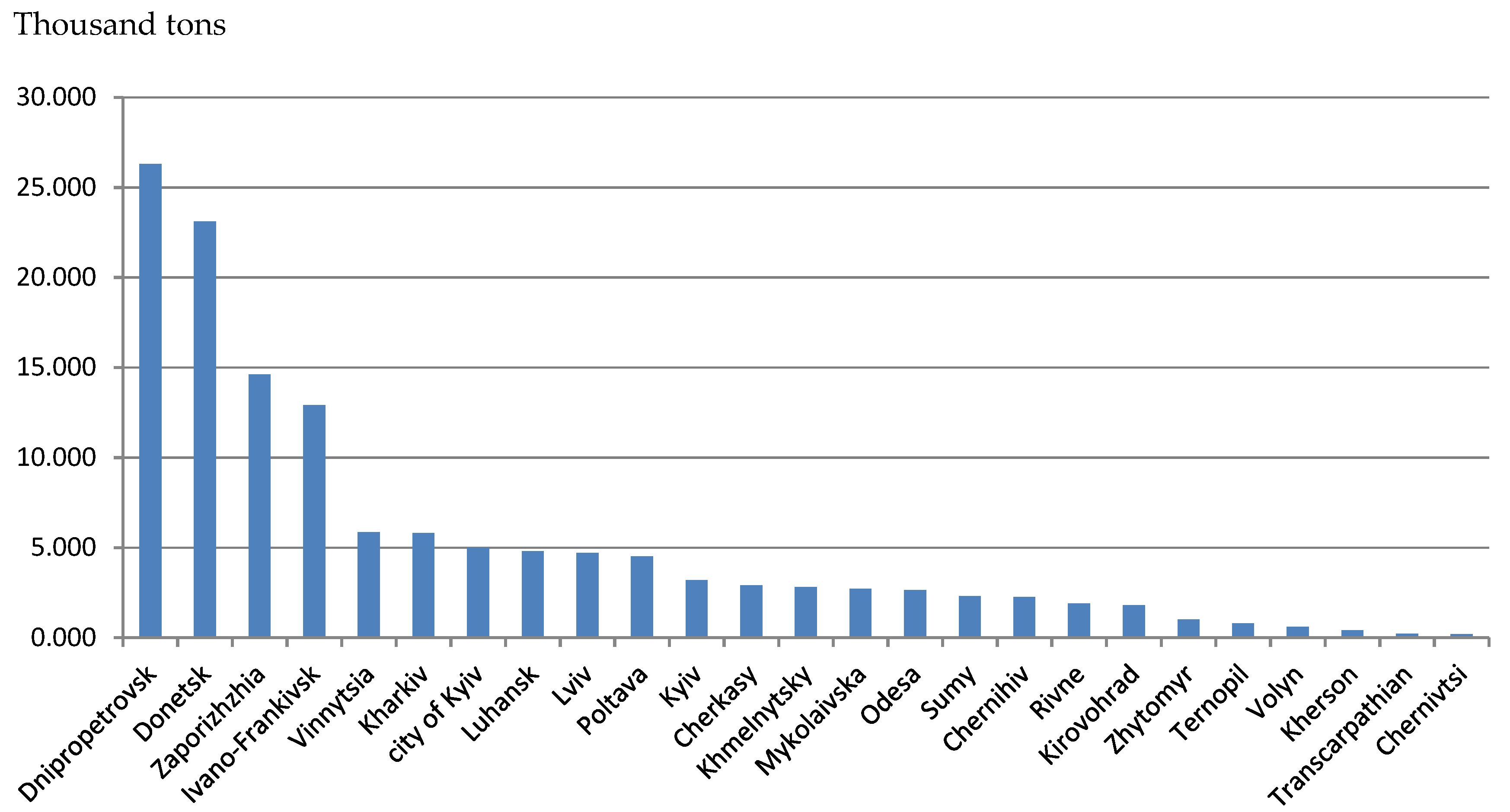
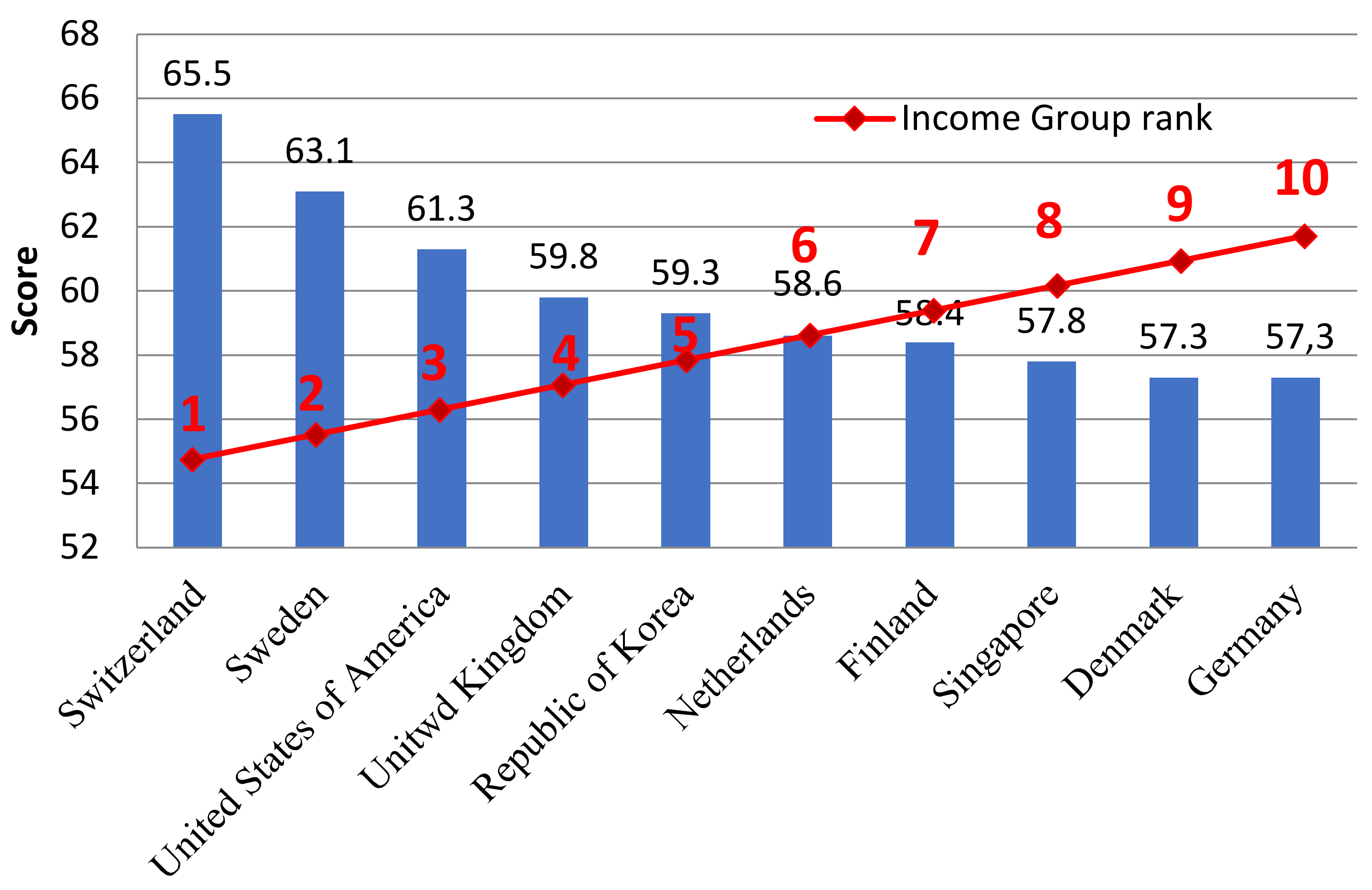
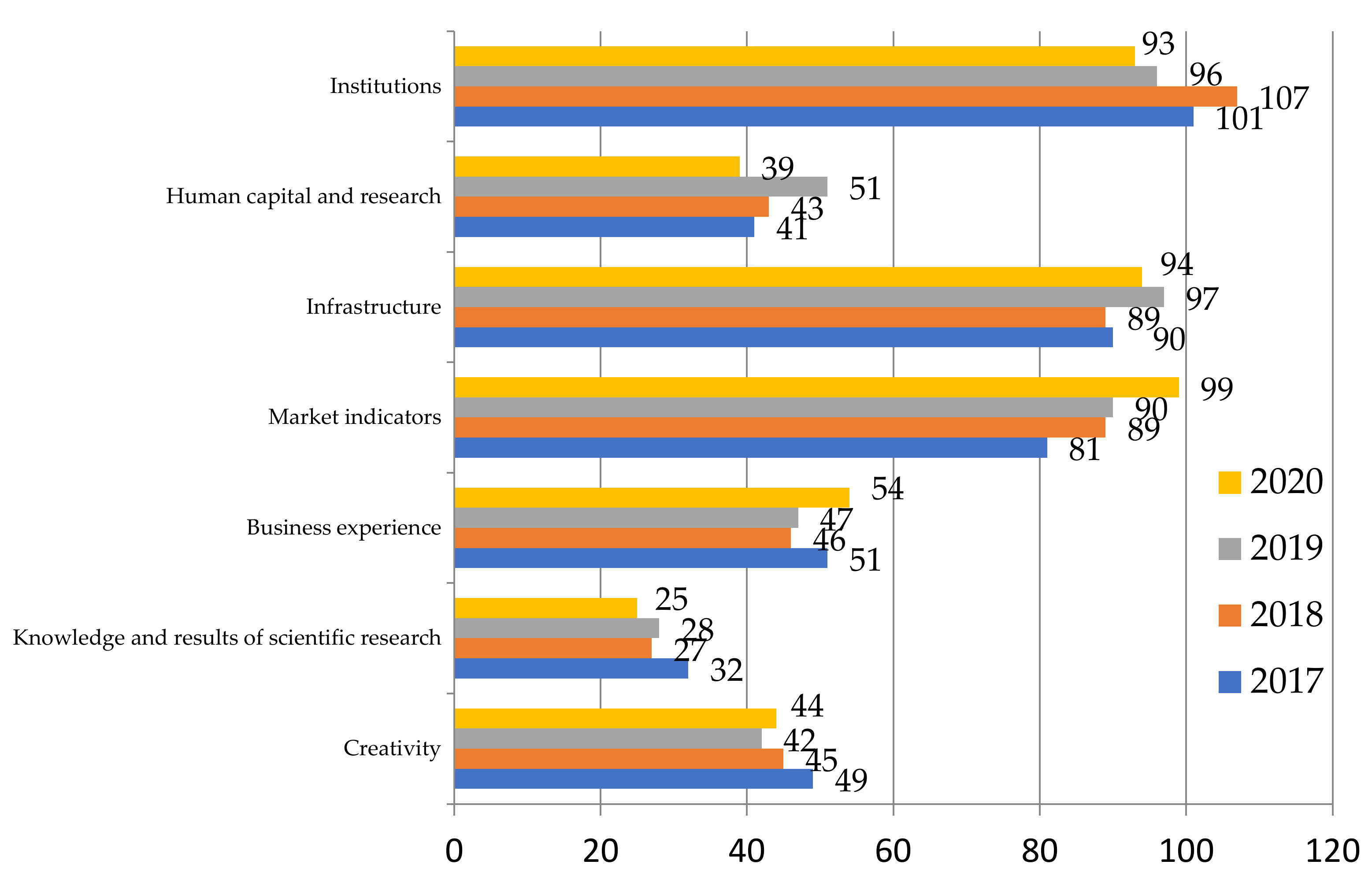
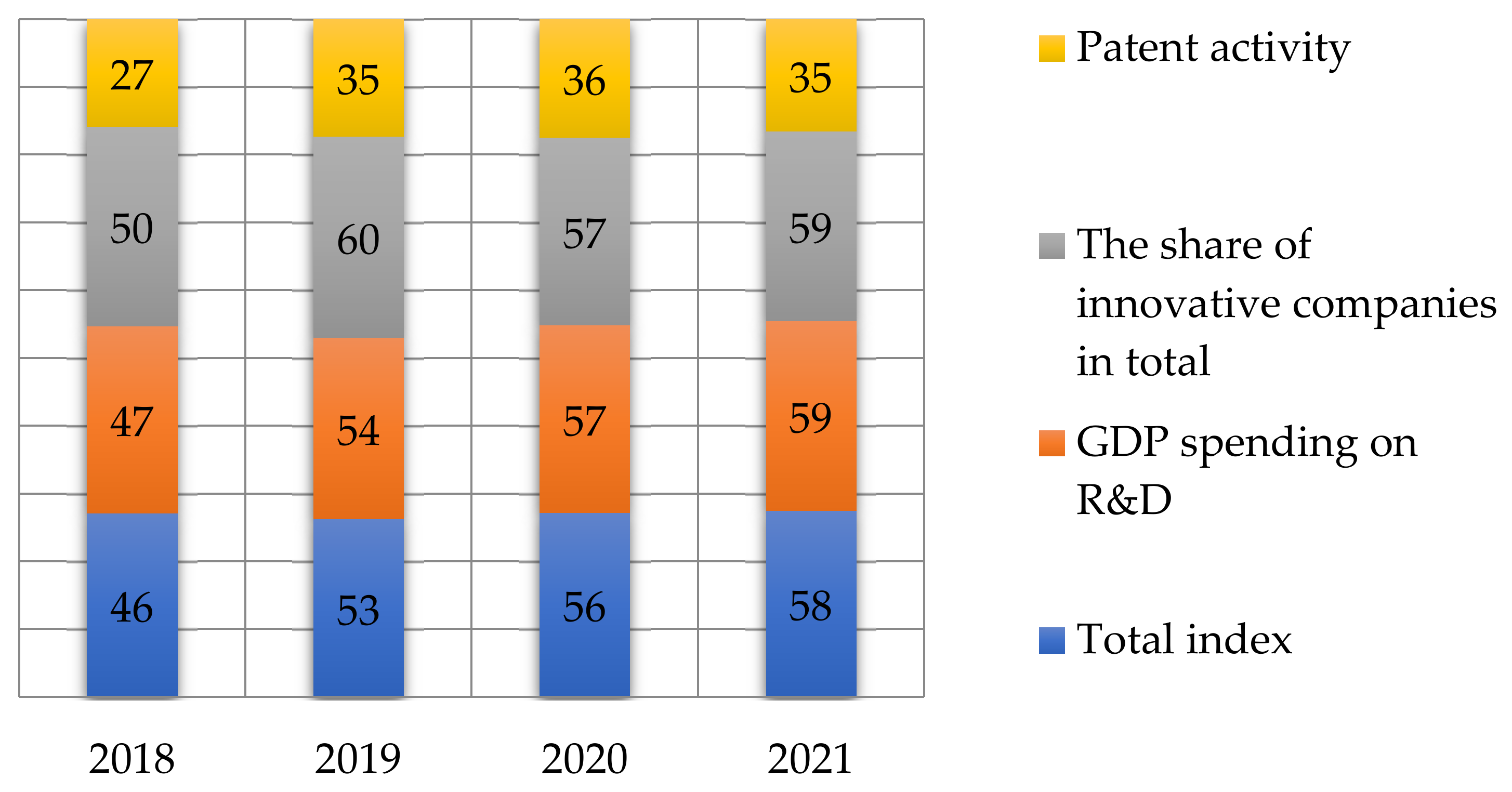
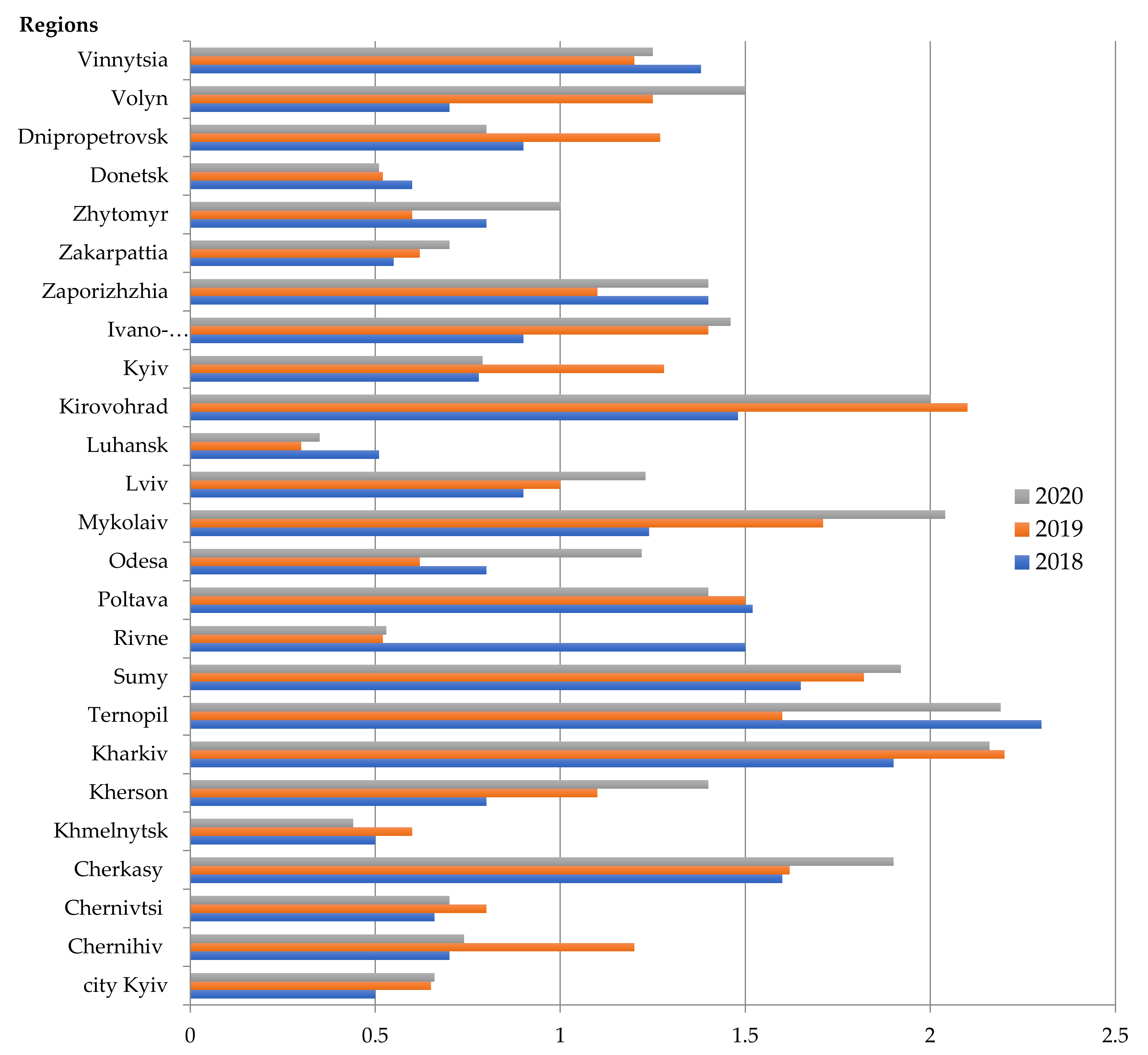
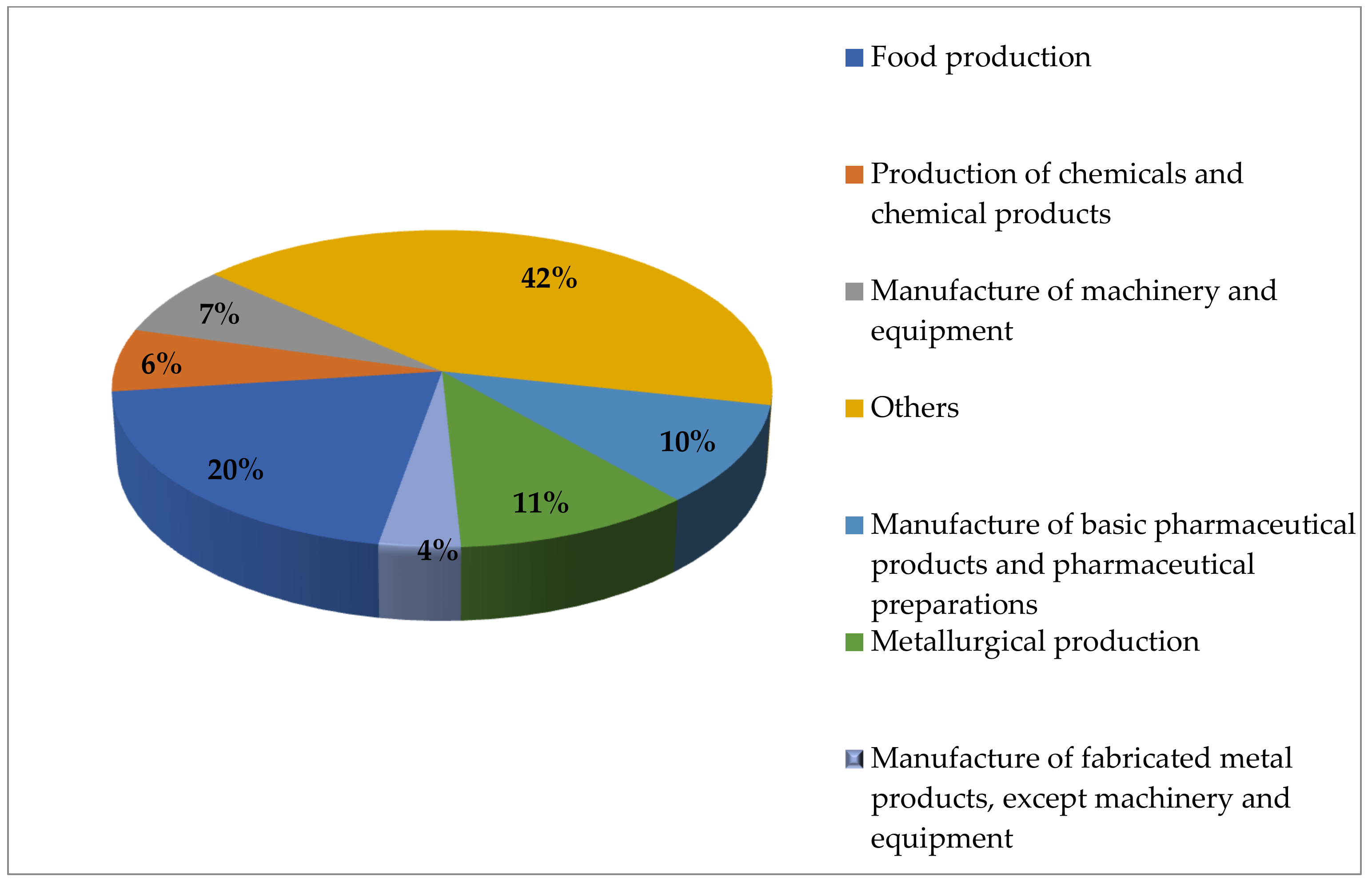
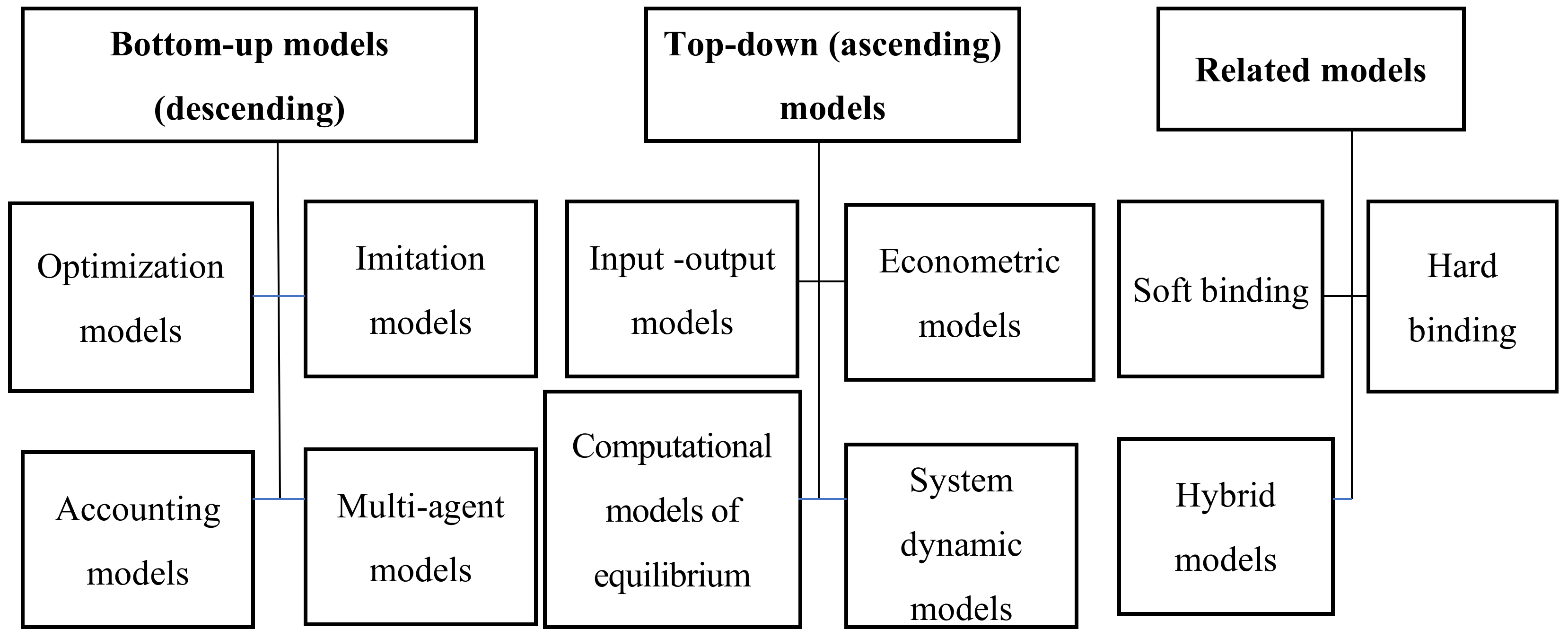
| The Order in the Queue to Resolve the Issue | 1 | 2 | 3 | 4 | 5 |
|---|---|---|---|---|---|
| Emissions of carbon dioxide into the atmosphere | Centre | South | East | West | North |
| Regions | 2018 | 2019 | 2020 | +/− 2020 before 2019 | +/− 2019 before 2018 |
|---|---|---|---|---|---|
| … | … | … | … | … | |
| Vinnytsia | 25 | 28 | 31 | 3 | 3 |
| Volyn | 14 | 11 | 12 | 1 | −3 |
| Dnipropetrovsk | 71 | 64 | 75 | 11 | −7 |
| Donetsk | 23 | 27 | 24 | −3 | 4 |
| Zhytomyr | 19 | 24 | 15 | −9 | 5 |
| Zakarpattia | 12 | 9 | 10 | 1 | −3 |
| Zaporizhzhia | 36 | 47 | 41 | −6 | 11 |
| Ivano-Frankivsk | 28 | 22 | 28 | 6 | −6 |
| Kyiv | 54 | 41 | 56 | 15 | −13 |
| Kirovohrad | 26 | 20 | 20 | 0 | −6 |
| Luhansk | 5 | 11 | 10 | −1 | 6 |
| Lviv | 44 | 44 | 60 | 16 | 0 |
| Mykolaiv | 14 | 22 | 14 | −8 | 8 |
| Odesa | 25 | 33 | 30 | −3 | 8 |
| Poltava | 30 | 32 | 35 | 3 | 2 |
| Rivne | 8 | 20 | 19 | −1 | 12 |
| Sumy | 25 | 23 | 23 | 0 | −2 |
| Ternopil | 20 | 29 | 35 | 6 | 9 |
| Kharkiv | 119 | 116 | 96 | −20 | −3 |
| Kherson | 14 | 13 | 14 | 1 | −1 |
| Khmelnytsk | 11 | 10 | 15 | 5 | −1 |
| Cherkasy | 29 | 30 | 31 | 1 | 1 |
| Chernivtsi | 9 | 7 | 13 | 6 | −2 |
| Chernihiv | 15 | 11 | 22 | 11 | −4 |
| City | 0 | 0 | |||
| Kyiv | 101 | 88 | 79 | −9 | −13 |
| … | … | … | … | … |
| Stakeholder | The Question Answered by the Related Model Complex |
|---|---|
| National regulators and central executive bodies | How and with what speed can the economy be decarbonised as efficiently as possible for the country? |
| Regulators at the international level | How and when will most countries in the world be able to achieve the goals of the Paris Agreement? |
| Financial sector | What are the possible consequences of the complete cessation of funding for carbon-intensive projects? |
| Business community | How can a company be decarbonised as effectively as possible? How can a company’s real assets be adapted to climate change? |
| National climate organisations and climate activists | What are the possible consequences for the world in the event of non-acceptance of mitigation of climate change? |
| Population | How will decarbonisation/adaptation methods affect incomes, health and living standards? |
| Type of Decarbonisation Model | Functional and Structural Features | Disadvantages and Shortcomings |
|---|---|---|
| Descending models | Economists and governments commonly use descending models. These models focus on aggregating macroeconomic sectors. They are usually characterised by a simplified presentation of components and therefore do not fit the definition of sectoral policy. Their scope is to assess the impact of energy and climate policies on socio-economic sectors, such as social growth and social welfare, employment, etc. A top-down approach may also consider interdependence between sectors or countries. | Descending models lack technological details and are limited to modelling financial policy instruments. This study has methodological limitations. The parameters of elasticity and autonomous efficiency in descending models were estimated based on empirical data. |
| Rising models | The ascending approach is to develop engineering models with a detailed description of the technological aspects of the energy system and how they may develop in the future, which allows the determination of sectoral policies. Energy demand is usually set exogenously, and models analyse how this energy demand should be met at minimal cost. However, the bottom-up approach does not consider the link between the energy system and macroeconomic sectors, thus ignoring the impact on these sectors. | Traditional ascending models describe technologies, but they realistically reflect the economic decisions made by enterprises and consumers when choosing technologies and do not reflect the potential feedback of macroeconomic equilibrium. |
| The Name of the Event | The Essence of the Event | Formalised Term in Equation (3) |
|---|---|---|
| Adoption of laws regulating the conditions for access to energy systems for installations of renewable energy sources (RES) | Adoption of laws regulating access to energy systems | |
| Establishment of special guaranteed tariffs for the purchase of electricity produced from RES and obligations for energy networks to purchase electricity | Transition to renewable energy sources (RES) | |
| Establishment of a mandatory share of electricity produced from RES in the balance of electricity sold by power grids | Establishment of special guaranteed tariffs for the purchase of electricity produced from RES as well as obligations for energy networks to buy this energy | |
| Financing research activities leading to a reduction in renewable energy cost | Establishment of a mandatory share of electricity generated from RES in the balance of electricity sales of power grids | |
| Establishment of state and other institutions to promote renewable energy, implement special programmes and demonstrate projects | Funding for research activities that reduce RES costs | |
| Preferential loans for purchasing renewable energy equipment and partial returns on investment for consumers | Establishment of state institutions for the promotion of RES and implementation of special projects | |
| Accelerated depreciation of RES equipment | Preferential loans for purchasing RES equipment and partial returns on investment for consumers | |
| Organisation of public support and the introduction of voluntary forms of support, such as the purchase of green energy by consumers as well as the transparency of information on the share of clean electricity in the balance of energy networks | Accelerated depreciation of RES equipment | |
| Subsidising investment in renewable energy | Organisation of public support and introduction of voluntary forms of support, such as consumer purchases of “Green Energy” as well as transparency of information on the share of clean electricity in the balance of energy networks | |
| Tax exemptions and tax rate reductions | Subsidising RES investments |
Publisher’s Note: MDPI stays neutral with regard to jurisdictional claims in published maps and institutional affiliations. |
© 2022 by the authors. Licensee MDPI, Basel, Switzerland. This article is an open access article distributed under the terms and conditions of the Creative Commons Attribution (CC BY) license (https://creativecommons.org/licenses/by/4.0/).
Share and Cite
Koval, V.; Borodina, O.; Lomachynska, I.; Olczak, P.; Mumladze, A.; Matuszewska, D. Model Analysis of Eco-Innovation for National Decarbonisation Transition in Integrated European Energy System. Energies 2022, 15, 3306. https://doi.org/10.3390/en15093306
Koval V, Borodina O, Lomachynska I, Olczak P, Mumladze A, Matuszewska D. Model Analysis of Eco-Innovation for National Decarbonisation Transition in Integrated European Energy System. Energies. 2022; 15(9):3306. https://doi.org/10.3390/en15093306
Chicago/Turabian StyleKoval, Viktor, Oksana Borodina, Iryna Lomachynska, Piotr Olczak, Anzor Mumladze, and Dominika Matuszewska. 2022. "Model Analysis of Eco-Innovation for National Decarbonisation Transition in Integrated European Energy System" Energies 15, no. 9: 3306. https://doi.org/10.3390/en15093306
APA StyleKoval, V., Borodina, O., Lomachynska, I., Olczak, P., Mumladze, A., & Matuszewska, D. (2022). Model Analysis of Eco-Innovation for National Decarbonisation Transition in Integrated European Energy System. Energies, 15(9), 3306. https://doi.org/10.3390/en15093306








